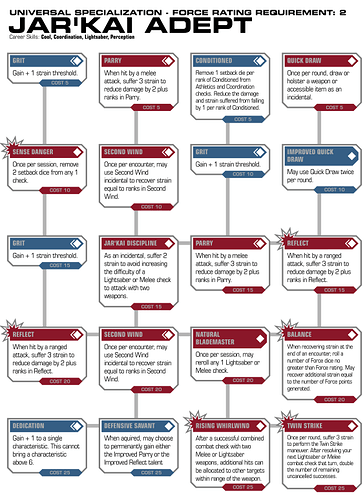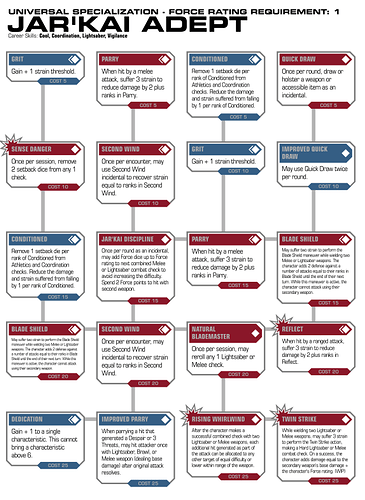Hello all! Like many others before me I have taken on the task of trying to make a Jar’kai homebrew spec. Seeing as the SWRPG subreddit is still locked away for the forseeable future, I thought it would be nice to get some feedback from the lovely people on this forum. My basic goal with this tree is to create a sort of advanced Lightsaber class that brings to life the fighting styles of Ahsoka Tano or Asajj Ventress within the game’s mechanics.
My main inspiration gameplay-wise was the Smuggler’s Gunslinger spec, particularly with some of the custom talents I made. I always thought it was weird that melee fighters never got talents that let them dual-wield effectively, and I wanted to rectify that with this tree. I also designed the tree with a Force rating requirement similar to some of the specs in the Jedi career from the Clone Wars sourcebooks to solidify the idea that it is an advanced class. I went with a FR 2 requirement because I figure it makes sense for a character to have a solid amount of training before committing to a dual-wielding style.
Here’s what I have so far:
I’ll give a little write-up of the Career Skills and talents, as well as my reason for including them.
Career Skills
- Lightsaber – Self-explanatory, necessary skill for a lightsaber spec
- Coordination – Representing the balance and agility necessary to wield two blades at once
- Cool – Representing a Jar’kai Adept’s ability to keep a level head during stressful situations
- Perception – Representing a Jar’kai Adept’s skill in observing the environment around them in the heat of battle
Necessary Talents (Existing):
- Quick Draw – Allows character to draw their blade at a moment’s notice
- Improved Quick Draw – Provides Jar’kai Adept with the same utility as the Smuggler Gunslinger spec, except for a melee combatant
- Dedication – Capstone talent
Core Talents (New):
- Jar’kai Discipline – When making a combined combat check with two Lightsaber or Melee weapons, the character may suffer two strain in order to refrain from increasing the difficulty of the check for attacking with two weapons. (Mirror of Guns Blazing from the Gunslinger spec)
-
Rising Whirlwind – After the character makes a successful combined check with two Lightsaber or Melee weapons, each additional hit generated as part of the attack can be allocated to any other target within range of the weapon. (Mirror of Spitfire from the Gunslinger spec)
Twin Strike – Suffer 3 strain to perform the Twin Strike maneuver. After resolving your next Lightsaber combat check that turn, double the remaining uncancelled successes. Can only be activated once per round.
INFO: The first two I’m comfortable with, since I see them as necessary utility for a dual-wielding melee spec. The only one that might need some reworking is Twin Strike. I want to include it since it’s one of the main moves of Jar’Kai (and I know SWRPG likes making talents based on lore accurate techniques) but I’m not sure I went about it perfectly. Basically I want it to be a sort of burst damage ability to represent the power of using two weapons in a single strike. Any ideas would be helpful
Strain Recovery Talents:
- Second Wind x2 – Allows the Jar’kai Adept to recover strain during an encounter
- Balance – Assists the character in recovering strain at the end of an encounter
- Grit x3 – An above average Strain Threshold for a Lightsaber form spec
INFO: The reason I’m including these strain recovery talents along with the above average strain threshold is to showcase the adaptability of a Jar’Kai Adept. Part of my design philosophy for this tree is that a dual-blade fighting style requires someone who can control the engagement and find spaces to catch their breath in the middle of a fight. By its nature it should be a tiring combat form, and these skills address that. I can definitely see the argument that this has TOO many strain recovery options for a combat tree, so I’m open to feedback there.
Defensive Talents:
- Parry x2 – Helpful in defending against melee attacks
- Reflect x2 – Helpful in defending against ranged attacks
- Defensive Savant (NEW) – When acquired, may choose to gain either the Improved Parry or Improved Reflect talent.
INFO: I think it’s important that a tree like this has a decent bit of defensive utility. Originally I was going to create a new ranked talent to buff a character’s defense using their second blade but that felt over complicated. Defensive Savant may seem op on the surface, but I like the idea of having an advanced lightsaber spec that lets you specialize in a form of defense that matches your style. Once again, it’s possible that I gave the tree too many defensive options, so I am open to suggestions.
Additional Talents:
- Sense Danger – Represents the adaptive ability of a Jar’kai Adept to twist a situation to their advantage
- Conditioned – Helps with Athletics and Coordination checks. Showcases a Jar’kai Adept’s physical training
- Natural Blademaster – Useful for a dual-wielding saber user and represents the characters advanced combat training
That’s the gist of it. Sorry this post is overly long, I know I’m throwing out a few radical ideas here so I wanted to explain myself. As a final note, the structure of this tree was inspired by the Gunslinger’s layout, but I am open to altering it if people think the current layout doesn’t fit the concept. Thank you for taking the time to check this out! ![]()

